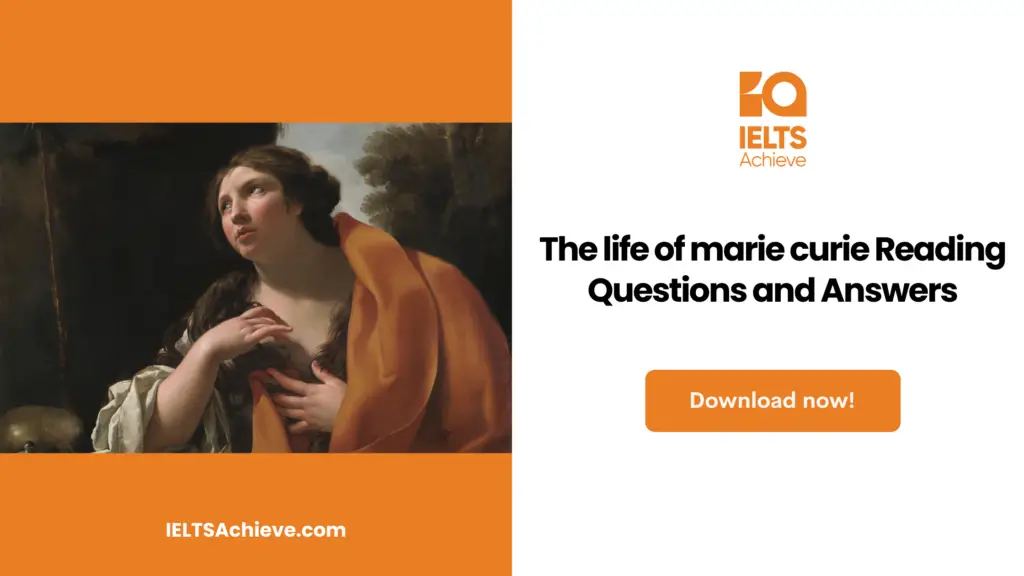The Blog post contains the following IELTS Reading Questions:
- IELTS Reading Sentence Completion
- IELTS Reading True/False/Not Given
- IELTS Reading Locating Information
Stay informed and prepared for success – Explore our comprehensive Reading Test Info page to get valuable insights, exam format details, and expert tips for mastering the IELTS Reading section.
IELTS reading passage – The life of Marie Curie

The life of Marie Curie
A Marie Curie is widely regarded as the world’s most famous female scientist. Maria Sklodowska, who was born in Poland in 1867, is best known for her radioactivity research. She was awarded the Nobel prize twice. She and her husband, Pierre Curie, shared the nobel prize in physics in 1903, and she was the sole recipient of the nobel prize in chemistry in 1911. She was the first female recipient of the Nobel prize.
B Marie was known for her exceptional memory since childhood, and when she was 16, she was awarded a gold medal for completing her secondary education. She was forced to work as a teacher because her father’s savings were lost due to poor investment. Her earnings allowed her to pay for her sister Bronia’s medical studies in Paris, with the understanding that Bronia would later help her get an education.
C In 1891, Marie kept her promise and moved to Paris to study at the Sorbonne(the university of Paris). She frequently worked late into the night, subsisting on bread, butter, and tea. In 1893, she won first place in the physical sciences examination and second place in the mathematical sciences examination. She didn’t meet Pierre Curie until the spring of that year.
D Their marriage in 1895 marked the start of the partnership that would soon have world-changing consequences. Following the discovery of a new phenomenon in 1896 by Henri Becquerel, which Marie later dubbed “ radioactivity,” Marie Curie decided to investigate whether the radioactivity discovered in uranium could also be found in other elements. She discovered that thorium behaved similarly.
E She was drawn to pitchblende, a mineral with radioactivity higher than pure uranium, which could only be explained by the presence of trace amounts of an unknown substance with extremely high activity in the ore. Pierre Curie worked with her to solve this problem, leading to the discovery of the new elements polonium and radium. Marie Curie worked tirelessly to obtain pure radium in its metallic state while Pierre Curie focused on the physical properties of the new radiations. This was accomplished with the assistance of Pierre Curie was awarded a Doctorate of science, and in 1903, Marie and Pierre shared the Nobel Prize in Physics with Becquerel for discovering radioactivity.Marie’s two daughters, Irène and Eve, were born in 1897 and 1904, respectively, and their births did not disrupt her scientific work. She was appointed physics lecturer at the École Normale Supérieure for Girls in Sèvres, France, in 1900, and introduced an experimental demonstration-based teaching method. In December 1904, she was appointed chief assistant in Pierre Curie’s laboratory.
F The unexpected death of Marie Curie’s husband in 1906 was a devastating blow, but it also marked a turning point in her career: she would now devote all of her energy to completing the scientific work that they had begun alone. She was appointed to the professorship left vacant by her husband’s death on May 13, 1906, becoming the Sorbonne’s first female professor. In 1911, she was awarded the Nobel Prize in Chemistry for isolating a pure form of radium.
G With the assistance of her daughter Irène, Marie Curie devoted herself to the advancement of X-radiography during World War I, including the mobile units known as ‘Little Curies,’ which were used to treat wounded soldiers. In 1918, Irène’s Radium Institute became a serious operation, evolving into a centre for nuclear physics and chemistry. Marie Curie, an Academy of Medicine member since 1922 and now at the pinnacle of her fame, researched the chemistry of radioactive substances and their medical applications.
H In 1921, Marie Curie triumphantly travelled to the United States with her two daughters to raise funds for radium research. In support of her campaign, local women presented her with a gram of radium. Marie also lectured in Belgium, Brazil, Spain, and Czechoslovakia, and she got to see the development of the Curie Foundation in Paris as well as the opening of the Radium Institute in Warsaw in 1932, where her sister Bronia became director.
I Marie Curie’s recognition of the need to accumulate intense radioactive sources, not only to treat illness but also to ensure an abundant supply for research, was one of her outstanding achievements. The presence of a 1.5 gram stock of radium at the Radium Institute in Paris was critical to the success of the 1930s experiments. This work paved the way for Sir James Chadwick’s neutron discovery and, more importantly, Irène and Frédéric Joliot-discovery Curie’s of artificial radioactivity in 1934. A few months after this discovery, Marie Curie died of leukaemia caused by radiation exposure. She’d kept test tubes containing radioactive isotopes in her pocket on a regular basis, remarking on the lovely blue-green light they emitted.
J Her influence on future generations of nuclear physicists and chemists was enormous, and not just because of her own work, the importance of which was demonstrated by her two Nobel Prizes.
Unlock your full potential in the IELTS Reading section – Visit our IELTS Reading Practice Question Answer page now!
Recommended Questions:
Renewable Energy IELTS Reading Question with Answer
The life of Marie Curie reading questions
Questions 1 – 7
Complete the notes below.Choose ONE WORD from the passage for each answer. Write your answers in boxes 1-7 on your answer sheet.
The research of Marie and Pierre Curie into the radioactivity of the mineral known as 1) __________ resulted in the discovery of two new elements. When uranium was discovered to be radioactive, Marie Curie discovered that the element known as 2) _____________ possessed the same property. Marie and Irene Curie invented X-radiography, which was used as a medicinal technique for 3) ____________________ Marie Curie recognised the significance of collecting radioactive material for research and for cases of contamination 4)______________ The radioactive material stored in Paris contributed to the 1930s discoveries of the 5)________________ and artificial radioactivity. In 1911, Marie Curie was honoured for her work on the element 6)_______________ Marie Curie was exposed to radiation during her research and suffered as a result 7)____________________
Enhance your sentence completion skills in the IELTS Reading section. Click here to access our comprehensive guide and learn effective strategies for filling in missing words or phrases in sentences.
Questions (8 – 12)
Do the following statements agree with the information given in the Reading Passage?
TRUE if the statement agrees with the information
FALSE if the statement contradicts the information
NOT GIVEN if there is no information on this
8) Marie took over husband’s teaching position.
9) As a child, Marie was fascinated by science.
10) Marie Curie’s husband shared both of Marie’s Nobel Prizes.
11) Bronia, Marie’s sister, researched the medical applications of radioactivity.
Enhance your skills in identifying information as True, False, or Not Given. Click here to discover expert strategies and techniques for mastering this question type in the IELTS Reading section.
Questions (12 – 15)
This reading passage has five paragraphs, A–E. Which paragraph contains the following information? Write the correct letter, A-E, as your answer to each question. Note: You may use any letter more than once.
12) Mari has a legendary memory from childhood.
13) became the first female professor at the Sorbonne University.
14) In order to raise funds for radium research.
15) The radium institute in Paris had a stockpile of 1.5 grams of radium, which was critical to the success of the 1930s experiments.
Unlock your full potential in the IELTS Reading section – Visit our IELTS Reading Practice Question Answer page now!
Recommended Questions:
Renewable Energy IELTS Reading Question with Answer
The life of Marie Curie reading answers
1. pitchblende
2. Thorium
3. Soldiers
4. Illness
5. Neutron
6. Radium
7. Leukaemia
8. True
9. Not given
10. False
11. Not given
12. B
13. F
14. H
15. I

We hope you found this post useful in helping you to study for the IELTS Test. If you have any questions please let us know in the comments below or on the Facebook page.
The best way to keep up to date with posts like this is to like us on Facebook, then follow us on Instagram and Pinterest. If you need help preparing for the IELTS Test, join the IELTS Achieve Academy and see how we can assist you to achieve your desired band score. We offer an essay correction service, mock exams and online courses.

